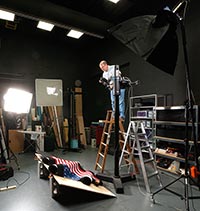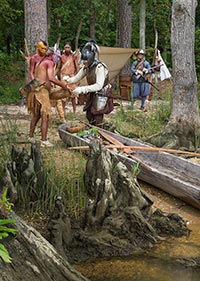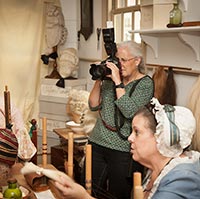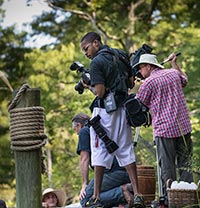Page content
Making a Great Impression
Colonial Williamsburg photographers at work
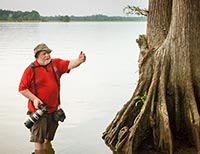
Doody waded into Powhatan Creek to direct models during a shoot depicting 17th-century commerce to produce an image of trade negotiations between Powhatan Indians and English settlers.
Capturing the beautiful simplicity of 18th-century life can be complicated. On one day, The Colonial Williamsburg Foundation's photographers may scout for the best spot to showcase Thomas Jefferson engaged in a passionate political debate. The next, you might see one of them in a cherry-picker snapping a view of the Historic Area that you wouldn't otherwise see. It's Dave Doody's favorite vantage point. "I'm not afraid of heights," says the manager of photo services at Colonial Williamsburg.
The one constant these photographers can depend upon is variety. Sometimes they find themselves in tight spaces, perhaps in the cupola atop the Governor's Palace. Other times, they're in the wide-open spaces capturing the march of the Continental army or galloping horses in a field or the Grand Illumination fireworks display. Tradesmen at work. Shoppers at the Market House. Still-life photos. The images you might see on a walk through the Historic Area.
"Some people think we spend all our time photographing antiques," Doody said. "Actually that isn't it at all — we illustrate ideas and tell the stories of 18th-century life."
Color. Design. Light. They're all factors in the image equation. So is setting the right mood for the shot.
Getting the best picture of people can sometimes be the biggest challenge, Doody says. Expressions, which are key to a successful shot, can be fleeting and the more people you add to the image, the greater the challenge becomes.
It's safe to say that the four photographers who chronicle the Foundation's work add several thousand images to the collection each month. And for a big event, like the Fourth of July celebration, the 2,000 or so they actually shoot will be edited down to several hundred of the best.
Doody says far more time is spent editing the images than shooting them. The department has used digital technology since 2000, eliminating the need to develop film. Seeing the photo more quickly is a bonus, but photographers still must go through the time-consuming process of judging each image and performing the cropping and color correction.
The views, of course, are the reward — and not just for the photographers. For many guests, the images of the Historic Area are iconic and capture memories of their own visit here.

